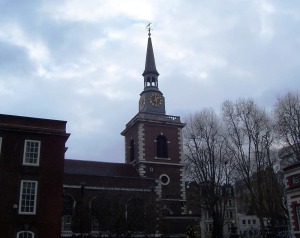At the end of my last post I left Adolphine Both and Sutherland Hall Sutherland at the altar of St James’s Church, Piccadilly, and I expressed some doubts about their prospects of wedded bliss. I will leave the telling of the story so far to the British Magazine (1830)
“The Misses Both. Our readers will recollect the romantic but unhappy story of these unfortunate Hanoverian sisters; of the five, two drowned themselves in Switzerland, they tied a shawl round their waists, and plunged together into the Lake of Geneva; the remaining three, it will be remembered, plunged from a boat off Greenwich Hospital, one of them perished, the other two were saved by the boatman; within the last few months, these two attempted to destroy themselves by taking laudanum at a house in the Regent’s Park – the life of one was saved, the other died. Perhaps the most extraordinary part of the story remains to be told. The newspapers, of course, carried the melancholy intelligence to Hanover, where it was perused by a gentleman of high rank and considerable wealth, had been many years ago attached to this only surviving one of the sisters. He immediately embarked for England, offered marriage to Miss Adolphine Both, – she is now his wife, and they are on the eve of embarking from London for Italy. To this we may add, that the statements of their near connection with the royal family of England are perfectly correct.”
The British Magazine referred to Adolphine Both as the only surviving one of the sisters, but there was of course another surviving sister, Palmyra, who had eloped with a British Army officer, Francis Crowther, and thus, according to some commentators, set in train the tragic events that were to follow.
The “gentleman of high rank and considerable wealth”, Sutherland Hall Sutherland, was an Army Officer. He was indeed extremely wealthy, having recently inherited a large sum from his father, James Sutherland, who was originally from Dornoch in Scotland and had amassed a fortune in India. In his father’s will, he is described as an “adopted son”, but, since he was baptized Sutherland Hall, he was in all probability an illegitimate son. Sutherland and Adolphine settled in London and the following year, 1831, their daughter Adolphine Christian Sutherland, was born. Adolphine senior died in Paris, aged 45, in 1846, and was buried in Montmartre cemetery. The reason for my pessimism about the chances of a happy marriage (or at least a faithful one) is the existence of the second Mrs Sutherland. Five years after being widowed Sutherland Hall Sutherland married for second time, at All Souls Marylebone, and Adolphine Christian acquired a younger step-sister. There is nothing unusual of course about a second marriage – many widows and widowers remarried and children often acquired step-parents and step-brothers and sisters. What is unusual about Sutherland’s second marriage is that his bride, Rebecca Steel, had been calling herself Rebecca Sutherland for at least ten years before her marriage. And her daughter, born in 1840, had been baptised Sutherland Rebecca and was in fact Adolphine Christian’s half-sister.
Sutherland Hall Sutherland died in 1856, leaving his wife well provided for (on the 1871 census she is living in Eaton Place and has 6 servants). The sisters, Adolphine Christian and Sutherland Rebecca, married within a few months of each other in 1859 and 1860. Adolphine Christian’s husband was solicitor Henry William Bradford, whose brother Edward Ridley Colborne Bradford would marry Jane Austen’s great-niece Elizabeth Adela Knight, while Sutherland Rebecca married Francis Vincent, a son of General Vincent of the Indian Army.
What, meanwhile, had happened to Francis and Palmyra who had married in Berne in 1825, following their elopement, and then settled in Deal, in Kent, and had a son, Francis Vivian Crowther? When the coroner in the inquest of Charlotte Both (one of the sisters who had killed themselves) said that “the whole family appeared to be in a state of insanity” he was probably referring to the sisters and not to Francis, but it was Francis who was declared a lunatic and admitted to the Military Asylum, Fort Clarence Barracks, Chatham. Palmyra, by now widowed, died in Brussels in 1847. Francis Vivian, orphaned in his teens, joined the Army as an ensign in the 15th Foot. He later emigrated to Australia and settled in Bendigo, Victoria. One of Francis Vivian’s uncles, William Crowther, had also emigrated to Australia, and a cousin, William Lodewyk Crowther, would become premier of Tasmania.


Hello and Happy New Year to you.
I was fascinated to read your two part story – A Hanoverian Tragedy – of the Misses Both. Lt Francis Crowther who married Palmyrera was, as you know, a brother of Dr William Wyatt Crowther, (arrived Aust. Jan 1985) who himself has his own controversial history in Tasmania. Dr Crowther’s marriage to Sarah Pearson in 1813 Macclesfield has produced many wonderful descendants in Tasmania and Victoria, my artist partner Geoffrey Hulme (70 years) and our two children Kali (actor) and Rhys (student) being some of them. Thank you for enlightening us with your descriptive and thorough tale. You have inspired me.
Cheers
Belinda Kirkwood
Small amendment to the above – Dr William Wyatt Crowther arrived Jan 1825.
And a happy new year to you too. It is nice to hear from some Crowther descendants. Since I wrote the post I have found a fascinating article about the Both sisters, published in the Illuminated Magazine in 1843. It gives more details about the life of the sisters before they came to England and can be read here
According to this account, Palmyra was abducted by Francis rather than eloping with him.